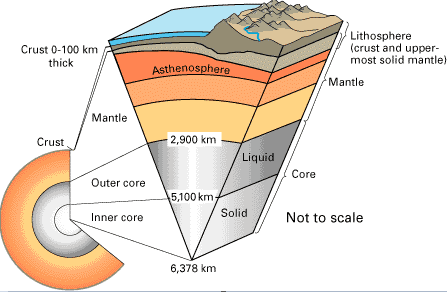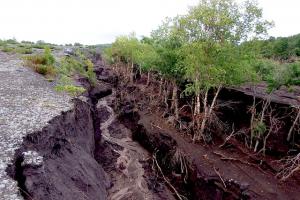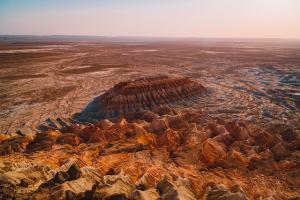The Interior Structure of the Earth - Interior Earth Layers
Interior Structure of the Earth

The interior structure of the earth is composed of three main layers: Inner core, outer core, mantle and crust.
The core is composed mostly of iron (Fe) and is so hot that the outer core is molten, with about 10% sulphur (S). The inner core is under such extreme pressure that it remains solid. Most of the Earth's mass is in the mantle, which is composed of iron (Fe), magnesium (Mg), aluminum (Al), silicon (Si), and oxygen (O) silicate compounds. At over 1000 degrees C, the mantle is solid but can deform slowly in a plastic manner.
Earth Crust:
The Crust
- Continental crust (25-40 km?)
- Oceanic crust (~6 km)
- Mantle
- Upper mantle (650 km)
- Lower mantle (2235 km)
- Core
- Outer core: liquid (2270 km)
- Inner core: solid (1216 km)
The crust in the interior structure of the earth is much thinner than any of the other layers, and is composed of the least dense calcium (Ca) and sodium (Na) aluminum-silicate minerals. Being relatively cold, the crust is rocky and brittle , so it can fracture in earthquakes. The shell of the earth, the crust, can be said to have two different thicknesses. Under the oceans, it is relatively thin. It varies in thickness from 5 to 8 km. Under the land masses, it is relatively thick. The thickness of the continental crust varies from 10 to 65 km. The eggshell analogy for the crust is not an exaggeration. It is paper thin compared with the radius of the earth which is approximately 6400 km.
The total weight of the continental crust is less than 0.3% of the weight of the earth. Variations in the crust thickness are compensated by the weight of the water and the differences in the specific gravities of the crust under the oceans (3.0 to 3.1) and under the continents (2.7 to 2.8). If one thinks of the crust as virtually floating on the mantle, one is less likely to wonder why the earth does not wobble as it rotates about its axis. The weight of the crust plus the mantle has a reasonably uniform distribution over the globe.
The Moho
The Moho, or the Mohorovicic Discontinuity, refers to a zone or a thin shell below the crust, in the interior of the earth that varies in thickness from 1 to 3 km. In seismology, the term "discontinuity" is used in its general sense. It refers to a change over a short distance of a material property. In this case, the "short distance" may be as long as 3 km, a trifle compared with the radius of the earth. In that zone, the P-wave velocity has been observed to increase from approximately 6 to approximately 8 km/sec. The Moho is considered to be the boundary between the crust and the mantle. The increase in P-wave velocity is ascribed to change in composition of the medium. Rocks of the mantle are poorer in silicon but richer in iron and magnesium
The Mantle
The mantle can be thought of having three different layers. The separation is made because of different deformational properties in the mantle inferred from seismic wave measurements.
(1) The upper layer is stiff.
It is presumed that if the entire mantle had been as stiff, the outer shell of the earth would stay put. This stiff layer of the mantle and the overlying crust are referred to as the lithosphere. The lithosphere is approximately 80-km thick
(2) Beneath the lithosphere is a soft layer of mantle called the asthenosphere.
Its thickness is inferred to be several times that of the lithosphere. One may think of this as a film of lubricant although film is not exactly the word for something so thick. It is assumed that the lithosphere, protruding (meaning: extending beyond) parts and all, can glide over the asthenosphere with little distortion of the lithosphere
(3) The mesosphere is the lowest layer of the mantle.
Considering the vagueness in defining the lower boundary of the asthenosphere it would be expected that the thickness and material properties of the mesosphere are not well known. It is expected to have a stiffness somewhere between those of the lithosphere and the asthenosphere.
The Core
It is known that the pressure increases toward the center in the interior of the earth. So does the temperature. The liquid outer layer versus the solid inner layer is rationalized by recognizing that the melting point of the material increases (with pressure) at a faster rate than the temperature as the center of the earth is approached.







